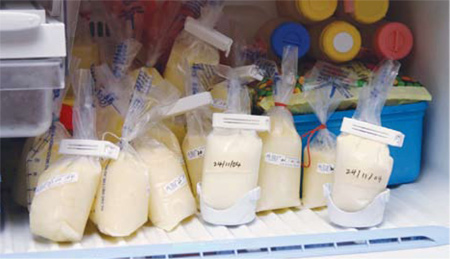In our previous issue, we talked about the issue on expressing milk and its different methods. In this final part, we will walk you through how to store your expressed breast milk properly and to prepare them for your baby. Enforcing the proper storing and preparation techniques is important to uphold the hygienic and nutritional properties of breast milk.
Storage Containers
There are generally two options, in which you can choose to store your breast milk:
Hard-sided containers. Usually made from hard plastic or glass, these are the preferred containers for long-term human milk storage. Choose one with an airtight seal.

Plastic bags (specifically designed for breast milk storage). Only use this option for short-term use as they may spill, leak, or become contaminated more easily than hard-sided containers. Some important milk components may adhere to the soft plastic and deprive your child of it.
- Wash your hands prior to expressing milk.
- Store in small portions (2-4 ounces/60-120 mL) to minimise waste.
- Consider storing smaller size portions (1-2 ounces/30-60 mL) each for unexpected situations. A small amount of milk can keep a baby happy until mom comes to nurse the baby.
- You may combine breast milk expressed throughout the day to get the desired volume in a container. Chill the newly expressed milk for at least 1 hour in the main body of the refrigerator or in a cooler with ice or ice packs, and then add it to previously chilled milk expressed on the same day.
- Do not add warm breast milk to frozen milk because it will partially thaw the frozen milk. Also, do not mix milk from separate days.
- Leave some room at the top of a container because breast milk expands as it freezes.
- Label containers clearly with the date using waterproof labels and ink, if possible.
Additional Pointers!
Tip #1: Milk will “separate” during storage. The top of the milk (the cream) will look thicker and whiter. Gently swirl the container to mix the separated milk BUT avoid vigorously shaking the container.
Tip #2: Depending on maternal diet, the color of breast milk may vary daily (bluish, yellowish or brownish). Frozen breast milk may also smell different than fresh breast milk but there is no reason not to use the milk if the baby accepts it.
Preparing to Feed Baby: Thawing or Warming the Breast Milk
- Use the oldest milk first.
- Baby may drink the milk cool, at room temperature, or warmed.
- Thaw milk by placing it in the refrigerator the night before use or gently re-warm it by placing the container under warm running water or in a bowl of warm water. Do not let the level of water in the bowl or from the tap touch the mouth of the container.
- Breast milk may be kept in the refrigerator for 24 hours after it is thawed.
- NEVER use a microwave oven or direct heat on the milk. These may cause scald spots and will also destroy antibodies.
- Swirl the container of milk to mix the cream back in, and distribute the heat evenly. Do not stir the milk.
- Milk left in the feeding container after a feeding should be discarded and not used again.
- As with all foods, do not re-freeze breast milk once it is thawed or partially thawed.
Author’s Note: The author is contributing this article to Positive Parenting as she is keen to provide evidence-based information to parents. However, as a baby-food company is a sponsor of Positive Parenting, the author has declined to accept any payment for this article from Positive Parenting as she is an International Board Certified Lactation Consultant and is bound by the Code of Ethics to not accept any kind of support from baby food companies.








Comments